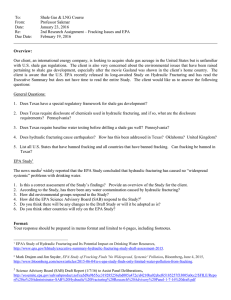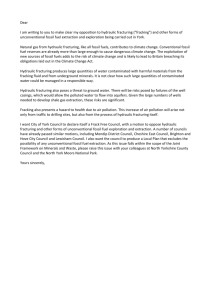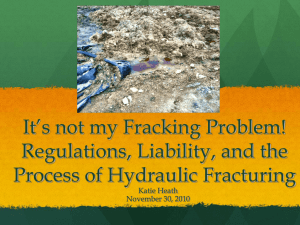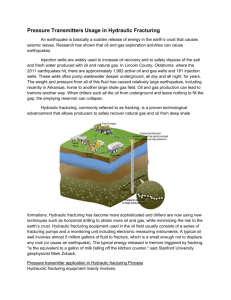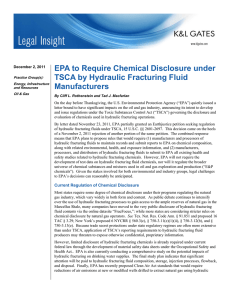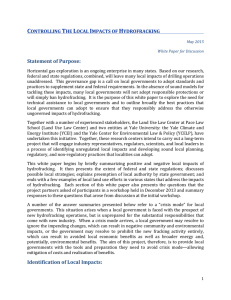Fracking Fluid & BTEX: Health Effects on Drinking Water
advertisement
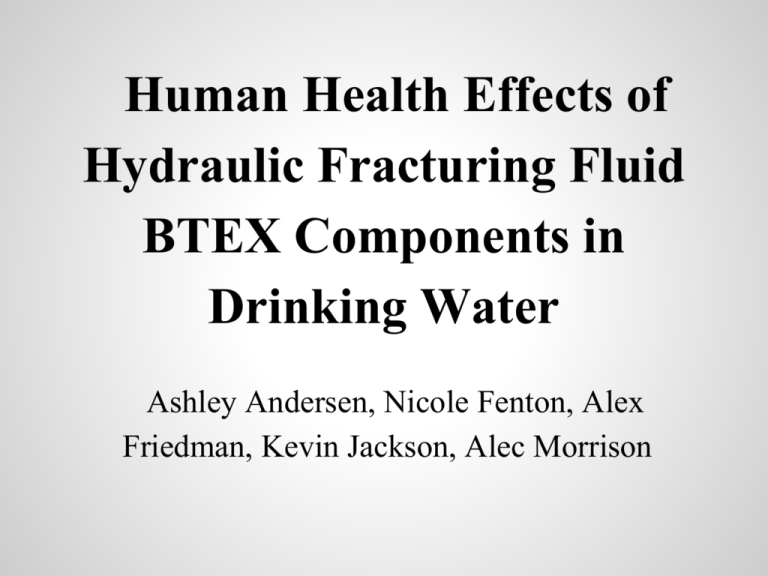
Human Health Effects of Hydraulic Fracturing Fluid BTEX Components in Drinking Water Ashley Andersen, Nicole Fenton, Alex Friedman, Kevin Jackson, Alec Morrison What is Hydraulic Fracturing? - Hydraulic fracturing (fracking) pumps chemicals into the ground to extract natural gases from the earth. - Once in the soil, they can become contaminants in our groundwater supply. Fracking Rig Also... - Hydraulic Fracturing is a relatively new process - So... information on this topic is limited & often biased depending on affiliations. https://encrypted-tbn3.google.com/images?q=tbn:ANd9GcReD2AZgBz3-1q4iiFaFM9vE2aNrhEAv59nsDLJY0ntMKRJQhm7qA Hydraulic Fracturing is on an Upward Trend! http://www.epa.gov/hfstudy/HF_Study__Plan_110211_FINAL_508.pdf Where does Fracking exist? More details on "Fracking" -Process entails drilling a well deep into shale that contains natural gas. -Injected with a high pressure mixture of water, sand and chemical solutions. -Although the goal is for the solution to remain deep in the ground -This could lead to both acute and chronic exposures to these chemicals. Did you know? Many of the chemical compounds that are commonly used in hydraulic fracturing are already regulated under the Safe Drinking Water Act & Clean Air Act! http://2.bp.blogspot.com/-7PECGW_wAME/To7ubwfB_OI/AAAAAAAAGlw/5NjFFmpb9VQ/s1600/000.png So how is Fracking even legal? - An exemption referred to as the “Halliburton Loophole Act.” - The permanent underground injection of chemicals used for hydraulic fracturing is not regulated by the Environmental Protection Agency unless diesel is used. (EPA, 2001) It's concerning because... -the EPA has identified many common chemical components known to have multiple negative health impacts. -These include BTEX compounds (Benzene, Tolulene, Ethylbenzene & Xylene) - classified as unsafe under the Safe Water Drinking Act, Clean Air Act and are potentially carcinogenic. -these are VOCs so avoiding consumption does not necessarily protect you - definite reason for concern, further study & legislation. -Many people get water from drinking wells that are located above fracking sites, and many chemicals and gasses can leach up to contaminate them! Water Wells in comparison to Fracking Wells - EPA Plan to Study the Potential Impacts of Hydraulic Fracturing on Drinking Water Resource - Using groundwater monitoring wells for contaminant testing http://www.epa.gov/hfstudy/HF_Study_ _Plan_110211_FINAL_508.pdf Our Focus: - BTEX compounds in hydraulic fracturing fluid and their proven impacts/health effects on humans. - Possible exposure pathways and probability/level of risk for people Pathways of Exposure -Inhalation of VOC's -Contact with skin (dermal) -Ingestion (via consumption of drinking water) Lethal Doses of BTEX in Mice http://www.springerlink.com/content/h377437740432527/ Possible health effects of Benzene - Highly flammable -Is classified under SDWA, is a HAP & carcinogenic -EPA has set an enforceable regulation for benzene, called a maximum contaminant level (MCL), at 0.005 mg/L or 5 ppb. - Found in: - crude oil - gasoline - cigarette smoke Chronic exposure can lead to: - anemia - decrease in blood platelets - may have an increased risk of getting http://water.epa.gov/drink/contaminants/basicinformation/benzene.cfm cancer Possible Health Effects of Toluene - Used in the production of benzene and urethane - Is classified under the SDWA and is a HAP - Maximum Contaminant Level (MCL) = 1 milligram per Liter (mg/L) or 1 parts per million (ppm) Chronic exposure can lead to problems in the: - Nervous system - Kidneys - Liver http://water.epa.gov/drink/contaminants/basicinformation/toluene.cfm Possible health effects of Ethyl Benzene - Chronic exposure can lead to: - liver or kidney problems. - Is classified under the SDWA and is a HAP - Exposure can be ototoxic (impairs auditory functions) http://water.epa.gov/drink/contaminants/uploa d/mcl-2.pdf Possible health effects of Xylene - Produced from petroleum or coal tar - Is classified under the SDWA and is a HAP -Maximum Contaminant Level (MCL)=10 milligrams per Liter (mg/L) or 10 parts per million (ppm) - One of the most commonly used solvents in: - Paint - Printing http://annhyg.oxfordjournals.org/content/47/4/331.full.pdf+html - Chronic exposure can cause damage to the nervous system http://water.epa.gov/drink/contaminants/basicinformation/xylen es.cfm http://democrats.energycommerce.house.gov/sites/default/files/documents/ Hydraulic%20Fracturing%20Report%204.18.11.pdf Gasland www.gaslandthemovie.com The EPA says: http://www.epa.gov/hfstudy/HF_Study__Plan_110211_FINAL_508.pdf http://www.epa.gov/hfstudy/HF_Study__Plan_110211_FINAL_508.pdf
